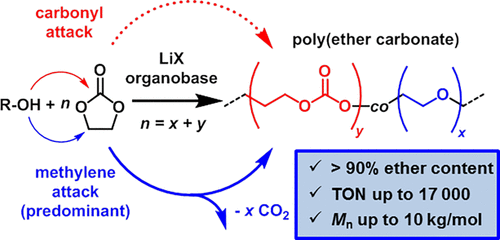当前位置:
X-MOL 学术
›
Biomacromolecules
›
论文详情
Our official English website, www.x-mol.net, welcomes your feedback! (Note: you will need to create a separate account there.)
Dual Catalytic Ring-Opening Polymerization of Ethylene Carbonate for the Preparation of Degradable PEG.
Biomacromolecules ( IF 6.2 ) Pub Date : 2020-05-18 , DOI: 10.1021/acs.biomac.0c00360 Nils von Seggern 1 , Tamara Schindler 1 , Stefan Naumann 1
Biomacromolecules ( IF 6.2 ) Pub Date : 2020-05-18 , DOI: 10.1021/acs.biomac.0c00360 Nils von Seggern 1 , Tamara Schindler 1 , Stefan Naumann 1
Affiliation

|
A dual catalytic setup, consisting of a range of different Lewis bases (including N-heterocyclic olefins, phosphazenes and nitrogen bases) and simple Lewis acids (such as LiCl, MgF2, BEt3), was employed to prepare poly(ether carbonate)s from five-membered, cyclic ethylene carbonate (EC). Polymerizations were conducted under microwave irradiation at T = 160–200 °C with low catalyst loading (0.4–0.005 mol % regarding organobases) in the bulk, enabling access to molar masses of up to 10 000 g/mol. A combination of kinetic investigation, GPC, MALDI-ToF MS, and NMR analysis underlines that the polymerization can be highly effective (TON up to >17 000) but side reactions still occur, resulting in a moderately controlled process. In contrast to traditional procedures, where increased ether contents can typically only be realized by higher temperatures and longer reaction times (at the cost of much reduced molar masses), the dual catalytic approach reveals the choice of the Lewis acid as a more effective tuning parameter for this property. Thus, while carbonate contents of up to 30% are possible, application of LiCl as cocatalyst provides a polymer with high ether content (90–99%, Mn = 800–10 000 g/mol), a finding that also seems to apply for other lithium salts. Thus, using this operationally simple setup and EC as a cheap feedstock, a copolymer which is essentially a degradable poly(ethylene glycol) can be prepared in a one-pot, one-step approach. Notably, the obtained low-carbonate content allows for the preparation of semicrystalline poly(ether carbonate), further underlining the “PEG-likeness” of the material.
中文翻译:

碳酸亚乙酯的双催化开环聚合反应制备可降解PEG。
使用由一系列不同的路易斯碱(包括N-杂环烯烃,磷腈和氮碱)和简单的路易斯酸(例如LiCl,MgF 2,BEt 3)组成的双催化装置制备聚(碳酸醚)来自五元环状碳酸亚乙酯(EC)。在微波辐射下于T进行聚合= 160–200°C,散装催化剂负载量低(相对于有机碱为0.4–0.005 mol%),可达到高达10,000 g / mol的摩尔质量。动力学研究,GPC,MALDI-ToF MS和NMR分析相结合,强调了聚合反应可以非常有效(TON高达> 17 000),但仍会发生副反应,从而控制了过程。与传统方法相反,在传统方法中,通常只能通过更高的温度和更长的反应时间(以大大降低的摩尔质量为代价)来提高醚含量,而双重催化方法则表明选择路易斯酸作为更有效的调节参数此属性。因此,虽然碳酸盐含量可能高达30%,但使用LiCl作为助催化剂可提供高醚含量(90-99%,M n = 800–10 000 g / mol),这一发现似乎也适用于其他锂盐。因此,使用这种操作简单的装置和EC作为廉价的原料,可以一锅一步的方法制备基本上是可降解的聚(乙二醇)的共聚物。值得注意的是,所获得的低碳酸盐含量允许制备半结晶聚(醚碳酸酯),进一步强调了材料的“ PEG状”。
更新日期:2020-07-13
中文翻译:

碳酸亚乙酯的双催化开环聚合反应制备可降解PEG。
使用由一系列不同的路易斯碱(包括N-杂环烯烃,磷腈和氮碱)和简单的路易斯酸(例如LiCl,MgF 2,BEt 3)组成的双催化装置制备聚(碳酸醚)来自五元环状碳酸亚乙酯(EC)。在微波辐射下于T进行聚合= 160–200°C,散装催化剂负载量低(相对于有机碱为0.4–0.005 mol%),可达到高达10,000 g / mol的摩尔质量。动力学研究,GPC,MALDI-ToF MS和NMR分析相结合,强调了聚合反应可以非常有效(TON高达> 17 000),但仍会发生副反应,从而控制了过程。与传统方法相反,在传统方法中,通常只能通过更高的温度和更长的反应时间(以大大降低的摩尔质量为代价)来提高醚含量,而双重催化方法则表明选择路易斯酸作为更有效的调节参数此属性。因此,虽然碳酸盐含量可能高达30%,但使用LiCl作为助催化剂可提供高醚含量(90-99%,M n = 800–10 000 g / mol),这一发现似乎也适用于其他锂盐。因此,使用这种操作简单的装置和EC作为廉价的原料,可以一锅一步的方法制备基本上是可降解的聚(乙二醇)的共聚物。值得注意的是,所获得的低碳酸盐含量允许制备半结晶聚(醚碳酸酯),进一步强调了材料的“ PEG状”。


























 京公网安备 11010802027423号
京公网安备 11010802027423号